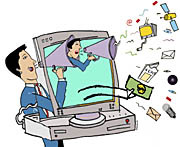They create clutter and are as inescapable as humidity in August. But just how annoying are those pop-up ads that appear unwanted on your computer as you cruise the Internet? How effective are they at selling stuff? E-commerce experts at Wharton and elsewhere say that pop-ups are not universally loathed and irrevocably worthless. Being intrusive does not necessarily translate into bad advertising.

Sign up to stay informed about our latest article releases.